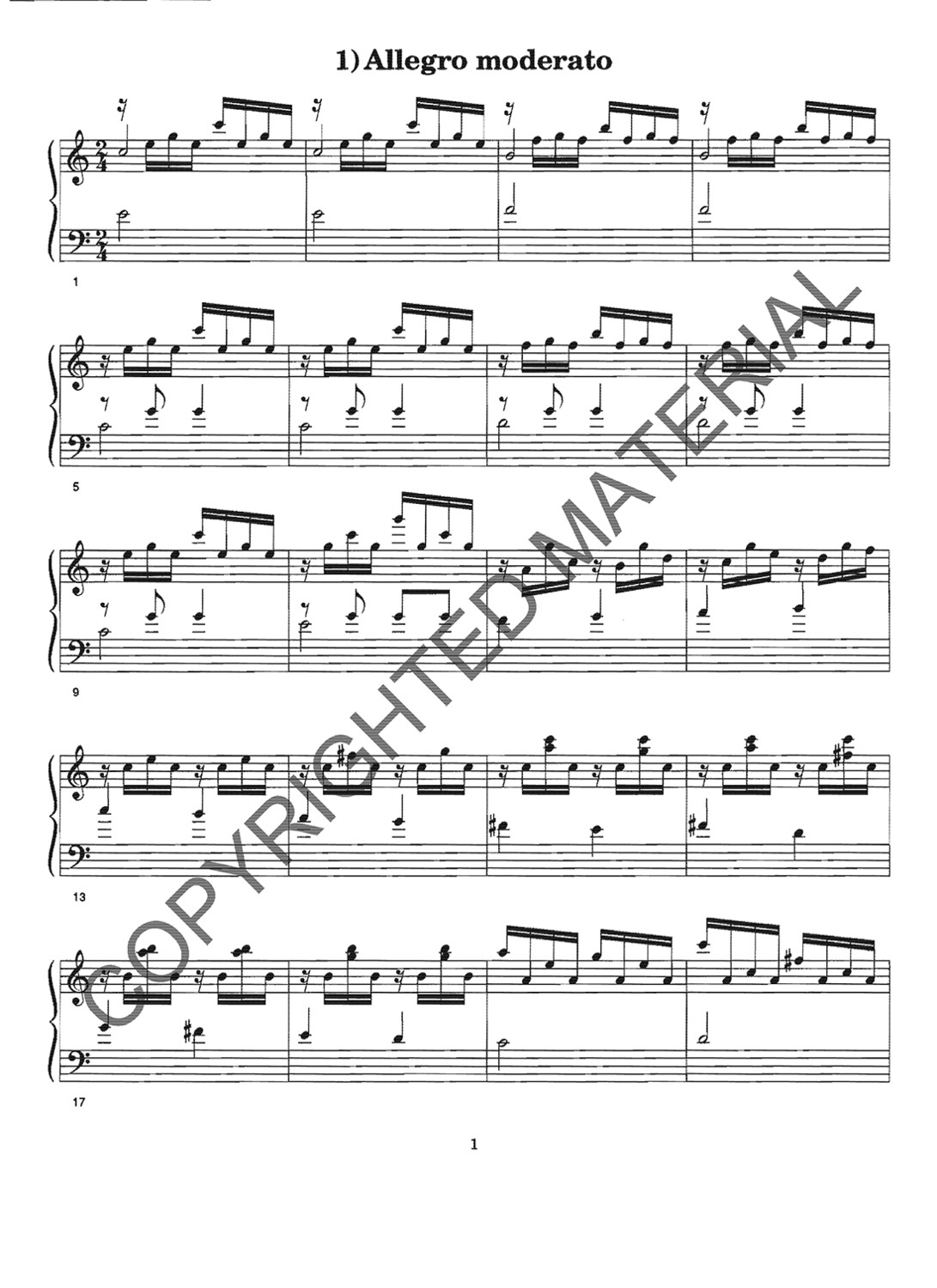
32 Pieces for Flute Clock
*This title is not available for digital download.
Collection contents
- Allegro moderato
- Andante
- Presto
- Andante
- Menuett
- Menuett
- Allegretto
- Menuette
- Allegro moderato
- Vivace
- Menuett
- Presto
- Allegretto
- Vivace
- Andantino
- Andante cantabile
- Menuett
- Vivace
- Allegretto
- Andante
- Vivace
- Menuett
- Allegro ma non troppo
- Fuga
- Marche
- Andante
- Allegretto
- Allegro
- Menuett
- Presto
- Allegretto
- Allegro
Front matter
The flute clock, an automatic musical instrument not necessarily connected to a clock mechanism as the name might imply, is a delicate apparatus consisting of a single register of flute "whistles" that sound at four-foot pitch. Three such musical automatons, build by P. Primitivus Niemecz in 1772, 1792 and 1793, and consisting of seventeen to twenty-nine flutes, contain a total of thirty pieces written expressly for these instruments by Franz Joseph Haydn. Niemecz, a monk and librarian to Prince Nikolaus Esterházy, was a student and friend of Haydn while both were in the employ of Prince Nikolaus. He entreated the great composer to write for his flute clocks and, in so doing, has provided us with not only the music, but also this invaluable resource for hearing the precise intentions of the composer for the performance of these pieces, in particular tempo, ornamentation and phrasing.
It is the combination of these two elements, extant manuscripts and flute clocks, that supports and documents the work of Dr. Ernst Fritz Schmid who compiled the first complete and authoritative edition of Haydn's flute clock works, Werke für das Laufwerk, Nagel 802, 1954. These transcriptions for carillon are based on the Nagel edition from which, also, is obtained the information for the foreword to this edition, the dating and numbering system and the title or tempo for each piece. The present edition, published by The Guild of Carillonneurs in North America, is made possible by permission of the copyright holder, Nagels-Verlag, 31 Heinrich Schütz Allee, Kassel-Wilhelmshöhe, West Germany.
There are three sets of pieces presented in an ascending scale of difficulty and dated according to the flute clocks on which they appear. The flute clocks of 1792 and 1793 contain twelve pieces each, nos. 1 through 12 and 19 through 30 respectively, numbered in the order in which they occur on each instrument. The flute clock of 1772 contains sixteen selections, four of which are from the 1792 set and six from the 1793 set. The remaining six, nos. 13 through 18 are found on this clock alone, hence they are dated 1772. The order of the sixteen pieces proceeds as follows: 23, 22, 13, 14, 15, 21, 16, 20, 19, 8, 6, 17, 11, 18, 2 and 24.
Six pieces, nos. 4, 5, 6, 9 and 10 from the flute clock of 1792, are not preserved in manuscript and, therefore, had to be notated by ear for the Nagel edition. Conversely, the last two pieces, nos. 31 and 32, which have not been found on any extant flute clocks, appear in manuscript only. Several of the pieces are transcriptions by Haydn himself of his own music. Of particular interest are nos. 29, the minuet from the "Clock" Symphony, and 32, the finale of the Tenth London Symphony. In addition, Haydn's authorship of nos. 10 and 25 has been authenticated by the presence of these pieces on the flute clocks.
By and large, tempo indications were not included in the original manuscripts. Those which have been provided editorially in the Nagel edition to indicate the tempo realized on the flute clock have been borrowed into this edition and appear in the parentheses in the index. Nos. 6, 16 and 18 were nicknamed by the Fux-Gassmann family to whom Haydn gave the 1772 flute clock.
Each transcription in this edition has been carefully handled. There are five basic components of the system that has been employed:
- Stem direction: stems up denote right hand; stems down, left;
- Notes connected by beams: observe the literal direction of the first stem and alternate thereafter except for...
- Hooking: a hook, or half moon above two or more notes indicates that all are taken with the right hand, below with the left hand, and...
- Repeated notes: these should be taken with the same hand except for...
- Crosses: change hands.
The character of each piece has been maintained insofar as it is possible on a carillon. Large carillons were of primary importance in the consideration of range, key, ornamentation, harmonic and melodic clarity and technical execution. Transformed on lighter carillons, these pieces will approach more nearly the affect [sic] generated on a flute clock. They can be played separately but are equally effective in pairs or groups. The set of 1792 is entirely in the original key of C major. No 7 begins in G major but concludes in C major as in the original edition. The selections from the 1772 set are all in E-flat major with the exception of no. 16 which is in the dominant key, B-flat, and no. 14 which digresses temporarily to E-flat minor. These pieces are in the key of F major in the original edition with no. 16 in the dominant key, C major, and no. 14, as before, digressing to the parallel minor. The last fourteen pieces in the original edition are in C major with the following exceptions: no. 25, D; 26, E; 27, G; 30, G; and 32, F. Scanning the last fourteen in this edition reveals that there are six in C major: nos. 19, 22, 23, 28, 29 and 30; six in E-flat major: nos. 20, 21, 24, 26, 31 and 32; and one each in the dominant keys of C major and E-flat major: no. 25 in G major and no. 29 in B-flat major. The uniformity of key with one digression to the dominant is in keeping with the tonal design of a suite and here lends itself well to that formal design if one cares to perform these pieces in groups, alternating selections of different tempos and meters.
Lastly, it should be noted that nos. 11 and 27 each contain two transcriptions for the same piece, a—easy and b—more difficult. However, there is only one piece for each in the original.
—Albert Gerken
